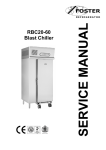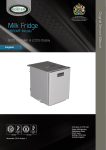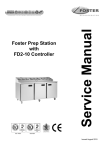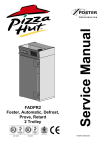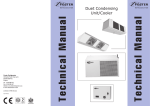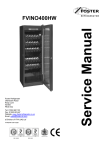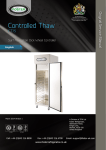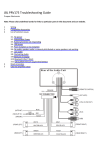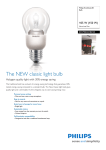Download Service Manual - Foster web spares
Transcript
Dough Retarder Prover Modular DRPTRI2 & 3 Models FB1-11 Touchpad Controller English ISO 9001 ISO 14001 November 2014 Version 1 Original Service Manual By Appointment to Her Majesty Queen Elizabeth II Suppliers of Commercial Refrigeration Foster Refrigerator, King’s Lynn A Division of ITW Ltd Foster Refrigerator, Oldmedow Road, King’s Lynn, Norfolk, PE30 4JU United Kingdom 1 Contents Page Manual Information & Health & Safety Notes 1 Environmental Management Policy 2 Disposal Requirements & Electrical Safety 2 DRPTRI Model Installation & Electrical Supply 3 Start Up, Controller Display & Icons 4-5 How To Run Cycles 5-6 User Adjustment & Parameter Setting 7 FB1-11 Default Parameter Values & Descriptions 8-14 Model Specific Parameter Values 15-17 Wiring Diagrams 18-22 Relay & Footprint Testing 23 Technical Data 24 Troubleshooting 25-27 Service Manual Information: The products and all information in this manual are subject to change without prior notice. We assume by the information given that the person(s) working on these refrigeration units are fully trained and skilled in all aspects of their workings. Also that they will use the appropriate safety equipment and take or meet precautions where required. The service manual does not cover information on every variation of this unit; neither does it cover the installation or every possible operating or maintenance instruction for the units. Health & Safety Warnings & Information Make sure the power supply is turned off before making any electrical repairs. To minimise shock and fire hazards, please do not plug or unplug the unit with wet hands. During maintenance and cleaning, please unplug the unit where required. Care must be taken when handling or working on the unit as sharp edges may cause personal injury, we recommend the wearing of suitable PPE. Ensure the correct moving and lifting procedures are used when relocating a unit. Do NOT use abrasive cleaning products, only those that are recommended. Never scour any parts of the refrigerator. Scouring pads or chemicals may cause damage by scratching or dulling polished surface finishes. Failure to keep the condenser clean may cause premature failure of the motor/compressor which will NOT be covered under warranty policy. Do NOT touch the cold surfaces in the freezer compartment. Particularly when hands are damp or wet, skin may adhere to these extremely cold surfaces and cause frostbite. Please ensure the appropriate use of safety aids or Personnel Protective Equipment (PPE) are used for you own safety. 1 Environmental Management Policy Product Support and Installation Contractors. Foster Refrigerator recognises that its activities, products and services can have an adverse impact upon the environment. The organisation is committed to implementing systems and controls to manage, reduce and eliminate its adverse environmental impacts wherever possible, and has formulated an Environmental Policy outlining our core aims. A copy of the Environmental Policy is available to all contractors and suppliers upon request. The organisation is committed to working with suppliers and contractors where their activities have the potential to impact upon the environment. To achieve the aims stated in the Environmental Policy we require that all suppliers and contractors operate in compliance with the law and are committed to best practice in environmental management. Product Support and Installation contractors are required to: 1. Ensure that wherever possible waste is removed from the client’s site, where arrangements are in place all waste should be returned to Foster Refrigerator’s premises. In certain circumstances waste may be disposed of on the client’s site; if permission is given, if the client has arrangements in place for the type of waste. 2. If arranging for the disposal of your waste, handle, store and dispose of it in such a way as to prevent its escape into the environment, harm to human health, and to ensure the compliance with the environmental law. Guidance is available from the Environment Agency on how to comply with the waste management ‘duty of care’. 3. The following waste must be stored of separately from other wastes, as they are hazardous to the environment: refrigerants, polyurethane foam, and oils. 4. When arranging for disposal of waste, ensure a waste transfer note or consignment note is completed as appropriate. Ensure that all waste is correctly described on the waste note and include the appropriate six-digit code from the European Waste Catalogue. Your waste contractor or Foster can provide further information if necessary. 5. Ensure that all waste is removed by a registered waste carrier, a carrier in possession of a waste management licence, or a carrier holding an appropriate exemption. Ensure the person receiving the waste at its ultimate destination is in receipt of a waste management licence or valid exemption. 6. Handle and store refrigerants in such a way as to prevent their emission to atmosphere, and ensure they are disposed of safely and in accordance with environmental law. 7. Make arrangements to ensure all staff who handle refrigerants do so at a level of competence consistent with the City Guilds 2079 Handling Refrigerants qualification or equivalent qualification. 8. Ensure all liquid substances are securely stored to prevent leaks and spill, and are not disposed of into storm drains, foul drain, or surface water to soil. Disposal Requirements If not disposed of properly all refrigerators have components that can be harmful to the environment. All old refrigerators must be disposed of by appropriately registered and licensed waste contractors, and in accordance with national laws and regulations. General Electrical Safety Foster Refrigerator recommends that the equipment is electrically connected via a Residual Current Device; such as a Residual Current Circuit Breaker (RCCB) type socket, or through a Residual Current Circuit Breaker with Overload Protection (RCBO) supplied circuit. 2 Installation Installation of these units should be carried out by a competent person and appropriate codes of practice adhered to thus ensuring safe installation (see installation guide for further details). Electrical Supply The correct electrical installation must be adhered to where the DRP is supplied with an isolator. The electrical supply must be terminated into the isolator in such a way that the supply can be controlled by the operator, When the DRP is supplied with a 5 pole electrical plug. A single purpose clearly marked isolating socket; of the type described below is to be provided to supply the DRP. The installation and testing of this socket should fall within the scope of the normal testing regime for the fixed electrical wiring of the site. Socket Type: > > > > > > Switched with mechanical interlock 32A size socket 400Vac 50/60Hz 3Pole+Neutral and Earth IP67 Fitted with: > > 20A 3 Phase MCB 3 Phase RCD (0.03A) NOTE: The plug, cable and socket are rated to 32A; however the supply socket should have MCB protection fitted at 20A / phase. Socket Position: The DRP is supplied with sufficient cable such that the supply socket should be positioned within a 5M (5000mm) radius from the centre of the DRP. This allows for the cable to route vertically 1M (1000mm) into a ceiling void, and then down a supporting surface to the socket positioned at around 1500mm from the floor level. 5000mm The socket must be positioned in sight of the DRP and readily accessible to act as an isolation point for the DRP. A suitable label should be positioned on the DRP identifying the location of the isolating socket. 3 Initialisation Screen After power is applied to the unit the controller display will show the booting screen. This will only show for a few minutes stating both ‘Booting’ and then displaying ‘Initializing’. When the controller has completed initialisation the screen will revert to the ‘Home’ screen. 'Home' Screen This is shown after initialisation and when no programmes are running. From this screen it is possible to run an automatic or manual cycle. Select the cycle type by pressing the relevant button on the touchscreen. This screen also shows the date, time and current air temperature and allows access to the ‘Settings Home Screen’ and ‘Information’ function. Touchpad Display Icons Humidity Percentage Air (T1) temperature Day & Current Time Cycle Description Cycle Time Remaining Surround Signal Cycle Progress Bar Stop/ Reset/ Hold Button Information Button (Some icons or switches are only visible during adjustment, when activated by parameters or through operation/ manual selection). Buttons & Icons Home – When selected on any screen this will revert you to the ‘Home’ screen Back - When pressed this will take you back to the previous screen Settings – This will take you into the ‘Settings Menu’ where changes can be made to the language, date, time etc. Information – When pressed this will give a summary of what is currently happing with the unit Alarm – Press this to view lists of active and historic alarms Delete – Use this to delete historic alarm warnings that require clearing from the ‘Alarm Log’ 4 Screen Feedback Signal When an icon or button is selected on screen a single beep will be heard to confirm the action requested. Surround Signal Colour Coding These four different screen surround signal colours represent the following: Service or Maintenance Mode. User modification in progress. Controller not operating or in Standby. Unit is ready for use. Process or system issue. User intervention required. Cycle under way or unit on operation. User attention not required. Stopping a Cycle or Function When shown on screen you can press and hold ‘Stop’, Finish’ or ‘Reset’ for 3 seconds, or until he progress blocks fill to halt a cycle or function. They must be pressed and held until the progression blocks are filled. If the process blocks are not filled the cycle will not stop and will continue the cycle. How to Run an Automatic Cycle Select & press ‘Auto’ Adjust end date & time then press ‘Start’ During the ‘Bake Time’ cycle the progress bar will fill and the time counts down. The cycle phase is indicated in steps (as shown to the left). 5 The alarm will sound to advise that the unit is ready for product to be loaded. Load product & press ‘Run’ The alarm will sound and then you can either extend the cycle or finish it (see next section for details) Finish the Cycle Extend the Cycle Press the ’Extend’ button and you will be taken to the Set Timer display. Set the timer and then press ‘Start’ To finish the cycle press the ‘Finish’ button and the cycle will end then revert the display to the ‘Home’ screen. How to Run a Manual Cycle Select & press ‘Manual’ Press ‘Timer’ to edit the cycle time. Timer shows. Select new cycle with ‘Timer’ or press and hold ‘Stop’ to end. Alarm sounds, load product & press ‘Run’ Auto’ Adjust end date & time. Press ‘Start’ Adjust time & press ‘Start’ Progress bar fills & time counts down Press & hold ‘Stop’. After ending the cycle the ‘Home’ screen will be shown. Silence an Alarm Load Alarm – press the green ‘Run’ button to continue the cycle and confirm product has been loaded into the unit Fault Alarm – Press the ‘Mute’ button to silence followed by the ‘i’ button for more information on the fault/warning. 6 User Adjustment Modes The following three screen options can all be accessed by starting from the ‘Home’ screen then by using the ‘Settings Icon’, select the ‘Settings Home Screen’. From here you can then select the menu required: Time/Date Setting Menu Select 'set Time & Date' Use directional arrows to set time & date. Press 'Set' to confirm or changes will be lost. Languages This controller only shows text in English Service Settings Menu Parameters Access to this menu is vital if you wish to adjust any parameter settings. Select 'Service Settings' Using arrows enter access code 1,3,1. If left for 20 seconds the home screen will show. Press 'Enter' If entered incorrectly the 'home' screen will show. If correct the service screen shows. Select the parameter set you wish to adjust. Cycle Parameter Sets Parameters should not be changed unless you have an understanding of their purpose and the following instructions are fully understood. This ‘Service Setting’ screen allows access to control and system parameter set up for the 2 cycle types 'Auto' and 'Manual' along with the 'System' set up and the relay test facility. To amend a ‘Cycle’ please follow these instructions after selecting the parameter set you wish to amend (as described above). If at any time the screen is left for 20 seconds amendments will be lost and the 'Home' screen will be shown: Scroll through list with up or down arrows on screen. Select the parameter to amend. Select new option Use cross or tick to confirm or reject new value and return to set menu. Depending on parameter type will show either Type new value. Select another parameter to amend or press the green tick to exit. To amend ‘System’ parameters the function is exactly as described above you just need to select ‘System’ rather than a cycle option. 7 FB1-11 Default Controller Parameter Values - Auto Cycle Section Chill Phase Retard Phase Recovery Phase Prove Phase Hard Phase Parameter Range Description Default Setting Chill Duration 0 to 360 min Duration of the chill phase. 60 Chill Set Point -50 to 120° Chill phase temperature set point. -8 Chill Hysteresis 0 to 25° Chill phase temperature hysteresis. 3 Chill Load Temp -50 to 120° Auto cycle ‘Do not load product’ temperature threshold offset point. 0 Chill Fan Speed 0 to 100 Evaporator fan speed during chill phase. Retard Set Point -50 to 120° Retard phase temperature set point. -5 Retard Hysteresis 0 to 25° Retard phase temperature hysteresis. 3 Retard Fan Speed 0 to 100% Evaporator fan speed during retard phase. 75 Recovery Duration 0 to 600 min Recovery phase duration. 360 Recovery Set Point -50 to 120° Recovery phase temperature set point. 8 Recovery Hysteresis -50 to 25° Recovery phase temperature hysteresis. 3 Recovery Lift 0 to 100% Recovery lift percentage (amount of recovery duration time to raise the temperature to recovery set point). 65 Rec. Lift Fan Speed 0 to 100% Evaporator fan speed during recovery lift phase. 100 Rec. Fan Speed 0 to 100% Evaporator fan speed during recovery phase. 100 Rec. Humidity Set 0 to 100% Recovery phase humidity setting. 85 Prove Duration 0 to 600 min Prove phase duration. 240 Prove Set Point -50 to 120° Prove phase temperature set point. 30 Prove Chill Hysteresis 0 to 25° Prove chill hysteresis – the differential from the set point before switching on cooling (subject to compressor rest). 2 Prove Heat Hysteresis -25 to 0° Prove heat hysteresis – the differential from the set point before switching on heating (subject to compressor rest). 2 Prove Lift 0 to 100% Prove phase lift percentage (amount of prove duration time taken to raise the temperature to the prove set point). 50 Prove Lift Fan Speed 0 to 100% Evaporator fan speed during lift phase. 85 Prove Off Fan Speed 0 to 100% Evaporator fan speed during prove ‘off’ cycle. 50 Prove On Fan Speed 0 to 100% Evaporator fan speed during prove heating or cooling cycle. 85 Prove Humidity Set 0 to 100% Prove phase humidity setting. 85 Hold Enable NO or YES Determination of hold function (NO = cycle stop + alarm sounds, YES = alarm sounds after ‘Auto End Timeout’ Hold is initiated, alarm muted). NO Hold Set Point -50 to 120° Hold mode temperature set point. 15 Hold Hysteresis 0 to 25° Hold mode hysteresis. 3 Hold Fan Speed 0 to 100% Evaporator fan speed during hold mode. 80 Hold Humidity Set 0 to 100% Hold mode humidity setting. 85 100 8 FB1-11 Default Controller Parameter Values - Manual Cycle Section Range Description Manual Set Point -50 to 120° Manual prove temperature set point. 30 Manual Chill Hysteresis 0 to 25° Refrigeration ‘On’ differential point – if T1>(‘Manual Set Point’ + ’Man Chill Hys’), then refrigeration switched on (subject to ‘Comp. Reset Time’). 3 Manual Heat Hysteresis -25 to 0° Heating ‘On’ differential point – if T1<(‘Manual Set Point’ – ‘Man. Heat Hys’), then prove heaters switched on. 1 Manual Load Temperature -20 to 50° Manual Cycle ‘ Do not load product’ temperature threshold set point. 20 Manual Fan Speed 0 to 100% Manual prove fan speed. 100 Manual Humidity Set 0 to 100% Manual prove humidity setting. 85 Clock Format 12/24 hr. Display/ setting format for time clock. 24H Daylight Saving Time NO or YES Daylight saving time adjustment on last Sunday in March (reverts back last Sunday in October). YES Auto Wait Timeout 0 to 120 min Length of time in Auto phase that ‘WAIT’ is displayed before de-energising relays, stopping the cycle and displaying ‘WARNING’ page without achieving temperature. 30 0 to 120 min Length of time in Auto phase that ‘LOAD’ is displayed before de-energising relays, stopping the cycle and returning to ‘Home’ screen with no intervention. 60 0 to 120 min Length of time in Auto phase that ‘EXTEND/ FINISH’ is displayed before de-energising relays, stopping the cycle with no intervention (‘HOLD’ not enabled) – EOC continue. 10 0 to 120 min Length of time in Manual phase that ‘WAIT’ is displayed before de-energising relays, stopping the cycle and displaying ‘WARNING’ page without achieving temperature. 30 0 to 120 min Length of time in Manual phase that ‘LOAD’ is displayed before de-energising relays, stopping the cycle and returning to ‘Home’ screen with no intervention. 60 Auto Load Timeout Manual Prove Default Setting Parameter Auto End Timeout Manual Wait Timeout Manual Load Timeout Temperature alarm threshold configuration: NON All temperature alarms are inhibited. RELATED The value set in ‘Low Diff’ & ‘High Diff’ are alarm differentials which relate to phase set point and cycle. Low Temp Alarm Diff -9.9 to 0° Low temperature alarm differential. (With ‘Low temp. air diff’ = ‘0’ the low temperature alarm is excluded). -5 High Temp Alarm Diff 0 to 9.9° High temperature alarm differential. (With ‘High temp. air diff’ = ‘0’ the high temperature alarm is excluded). 5 Temperature Alarm NON Temperature alarm probe: Temperature Alarm Probe 9 T1 Air temperature probe used for alarm detection. T2 Evaporator temperature probe used for alarm detection (If ‘Evaporator Probe Enable’ = YES). T3 Third temperature probe used for alarm detection (If ‘Auxiliary Input’ = ‘Cond’). T1 FB1-11 Default Controller Parameter Values - System Section System Parameter Range Description Default Setting Temperature Alarm Delay 0 to 120 min Delay before alarm temperature warning. 30 Door Alarm Delay 0 to 30 min Delay before ‘Door Open’ alarm warning. 8 Evaporator Fan Min Stop 0 to 90 sec Minimum evaporator fan stop period (following door opening etc.) 0 Compressor Rest Time 0 to 30 min Compressor rest time. 1 Control Hum. Thr. -0 to 90° Humidity temperature threshold (temperature at which humidity control is enabled). 15 Humidity Low -10 to 0% Variation below humidity set point level before humidity system activation. -3 Humidity High 0 to 10% Variation above humidity set point at which refrigeration system/ humidity alarm activation. 2 Humidity Alarm Delay 0 to 120 min Delay before humidity alarm warning 30 Humidity Probe Offset -10 to 10% Humidity probe offset. 0 Humidity Simulation 0 to 100 Displayed humidity slowdown. 10 Power Fail Alarm 0 to 120 min Power failure alarm time (if ‘Power fail alarm’ = ‘0’ power failure alarm is disabled). 0 Cond. Clean Warn. 0 to 52 Weeks Condenser clean period. (With ‘Cond. Clean warn’ = ‘0’ condenser cleaning alarm is disabled. 0 Data Logger NO or YES Data collection and download function (FCOM fitted/ download icon displayed). NO Screensaver Tmt 0 to 120 min Tim before starting screensaver from ‘Home’ screen (with value ‘0’ screensaver is not enabled and display remains constantly illuminated). 0 Configurable digital input operation: Not Used (NON) Digital input not activated. Door Switch (DOOR) Door switch input (if ‘Digital IP 0’ = ‘DOOR’ next parameter will be ‘DOOR DELAY’). Light Switch (LIGHT) Light switch operation (‘Relay 5’ = ‘LIGHT’ + ‘LIGHT MODE’ = MANUAL). Alarm If Open (AL OPN) Alarm (‘AL’ displayed) when contact opens. Alarm If Closed (AL CLS) Alarm (‘AL’ displayed) when contact closes. High Pressure Switch NO or YES Configurable 230Vac Input (D3) from high pressure switch to operate high pressure alarm. YES Low Pressure Switch NO or YES Configurable 230Vac Input (DS) from low pressure switch to operate low pressure alarm. NO Over Temp Switch NO or YES Configurable 230Vac Input (DS) from over temp stat to operate over temp alarm. YES Digital Input 0 NON 10 Section Parameter Range Description Default Setting Relay 2 Operation (relay contacts open when mains power removed): Not Used (NON) Output disabled (always off). Steam Heater (ST HTR) Control of humidity steam generator heater (activated in both ‘TANK’ and ‘PULSE’ mode). Prove Heater Control of prove heater. (PROVE) Relay 2 Steam Valve (ST VLV) Control of water solenoid valve (used with ‘PULSE’ humidity setting). EOC Alarm (EOC) Energises at end of cycle for indication. Light (LIGHT) Output enabled for light control. 0-1 (0-1) Contacts open/closes with ‘Run/ Standby’ mode. Open In Alarm (AL OPN) Contacts open when an alarm condition occurs. Closed Alarm (AL CLS) Contacts close when an alarm condition occurs. ST HTR EOC + Open Energises at end of cycle for indication but contacts In Alarm open when an alarm condition occurs. (EOC+AL) System Continued Relay 3 Operation (relay contacts open when mains power removed): Not Used (NON) Output disabled (always off). Steam Heater (ST HTR) Control of humidity steam generator heater (activated in both ‘TANK’ and ‘PULSE’ mode). Prove Heater Control of prove heater. (PROVE) Relay 3 Steam Valve (ST VLV) Control of water solenoid valve (used with ‘PULSE’ humidity setting). EOC Alarm (EOC) Energises at end of cycle for indication. Light (LIGHT) Output enabled for light control. 0-1 (0-1) Contacts open/closes with ‘Run/ Standby’ mode. Open In Alarm (AL OPN) Contacts open when an alarm condition occurs. Closed Alarm (AL CLS) Contacts close when an alarm condition occurs. EOC + Open Energises at end of cycle for indication but contacts In Alarm open when an alarm condition occurs. (EOC+AL) 11 PROVE Section Parameter Range Description Default Setting Relay 4 Operation (relay contacts open when mains power removed): Not Used (NON) Output disabled (always off). Steam Heater (ST HTR) Control of humidity steam generator heater (activated in both ‘TANK’ and ‘PULSE’ mode). Prove Heater Control of prove heater. (PROVE) Relay 4 Steam Valve (ST VLV) Control of water solenoid valve (used with ‘PULSE’ humidity setting). EOC Alarm (EOC) Energises at end of cycle for indication. Light (LIGHT) Output enabled for light control. 0-1 (0-1) Contacts open/closes with ‘Run/ Standby’ mode. Open In Alarm (AL OPN) Contacts open when an alarm condition occurs. Closed Alarm (AL CLS) Contacts close when an alarm condition occurs. NON EOC + Open Energises at end of cycle for indication but contacts In Alarm open when an alarm condition occurs. (EOC+AL) System Continued Relay 5 Operation (relay contacts open when mains power removed): Not Used (NON) Output disabled (always off). Steam Heater (ST HTR) Control of humidity steam generator heater (activated in both ‘TANK’ and ‘PULSE’ mode). Prove Heater Control of prove heater. (PROVE) Relay 5 Steam Valve (ST VLV) Control of water solenoid valve (used with ‘PULSE’ humidity setting). EOC Alarm (EOC) Energises at end of cycle for indication. Light (LIGHT) Output enabled for light control. 0-1 (0-1) Contacts open/closes with ‘Run/ Standby’ mode. Open In Alarm (AL OPN) Contacts open when an alarm condition occurs. Closed Alarm (AL CLS) Contacts close when an alarm condition occurs. EOC EOC + Open Energises at end of cycle for indication but contacts In Alarm open when an alarm condition occurs. (EOC+AL) 12 Section Parameter Range Description Default Setting Relay 6 Operation (relay contacts open when mains power removed): Not Used (NON) Output disabled (always off). Steam Heater (ST HTR) Control of humidity steam generator heater (activated in both ‘TANK’ and ‘PULSE’ mode). Prove Heater Control of prove heater. (PROVE) Relay 6 System Continued Steam Valve (ST VLV) Control of water solenoid valve (used with ‘PULSE’ humidity setting). EOC Alarm (EOC) Energises at end of cycle for indication. Light (LIGHT) Output enabled for light control. 0-1 (0-1) Contacts open/closes with ‘Run/ Standby’ mode. Open In Alarm (AL OPN) Contacts open when an alarm condition occurs. Closed Alarm (AL CLS) Contacts close when an alarm condition occurs. AL CLS EOC + Open Energises at end of cycle for indication but contacts In Alarm open when an alarm condition occurs. (EOC+AL) Alr Repeat Interval 0 to 720 min Time between an acknowledged alarm being muted and resounding (when it still exists). If ‘R6 RPT INT’ = ‘0’ the alarm will not record. EOC Max Duration 0 to 720 min The time the ‘End of Cycle’ (EOC) alarm sounds for before automatically muting (If ‘EOC PERIOD’ = ‘0’ the EOC alarm will not automatically mute). Light Control Mode: Light Mode Not Used (NON) Light control mode disabled (always off). DI0 Open (DO OPN) Light control is switched on when door is opened (If ‘DIGITAL IP 0’ = ‘Light’). DI0 Closed (DO CLS) Light control is switched on when door is closed (If ‘DIGITAL IP 0’ = ‘Light’). Door Open (DR OPN) Light control is switched on when door is opened (If ‘DIGITAL IP 0’ = ‘Door’). Door Closed (DR CLS) Light control is switched on when door is closed (If ‘DIGITAL IP 0’ = ‘Door’). NON Steam generation control mode: Steam Control 13 Not Used (NON) Steam control is disabled (always off). Tank (TANK) Steam is generated by tank heater (then ‘Relay 2’ = ‘Steam Htr’). Pulse (PULSE) Steam is generated by grid heater and injector (then ‘Relay 2’ = ‘Steam Htr’ + ‘Relay 4’ = ‘Steam Vv’). TANK Section Default Setting Parameter Range Description Hum. Power Thr -1% to -30% Point before humidity setpoint at which generation is switched from 100% power to value determined by ‘Steam Htr. On/ Steam Htr. Off’. -15 Steam Htr. On 30 to 240 sec Cyclic steam heater ‘On’ when generating humidity as determined by ‘Hum. Power Thr’. 60 Steam Htr. Off 30 to 240 sec Cyclic steam heater ‘Off’ when generating humidity as determined by ‘Hum. Power Thr’. 45 Pulse Delay 0 to 120 sec Delay time between humidity heater (Relay 2) being switched on and water valve (Relay 4) being energised. 20 Pulse On 0 to 120 sec Relay 4 steam valve operating cycle (open time) when humidity is required (i.e. the period of time relay 4 energised/ valve open). 1 Pulse Off 0 to 120 sec Relay 4 steam valve operating cycle (closed time) when humidity is required (i.e. the period of time relay 4 de-energised/ valve shut). 10 Air Probe Offset ‘-9.9 to 9.9°C Air temperature probe (T1) enabling. Evap Probe Enable NO or YES Evap Probe Offset ‘-9.9 to 9.9°C Evaporator temperature probe (T2) offset. Evaporator (T2) probe enabling. 0 NO 0 T3 Probe Function: System Continued Auxiliary Input Not Used (NON) Digital input T3 not activated. Door2 (DOOR2) Door switch input (works in series with ‘DO’ when ‘DO’ = ‘DS’), (If ‘T3’ = ‘DOOR2’ parameter ‘DOOR DELAY’ is activated). Alarm If Open (AL OPN) Alarm switch – ‘general alarm’ displayed when contact is open. Alarm If Closed (AL CLS) Alarm switch – ‘general alarm’ displayed when contact is closed. HP Switch (HP) High pressure switch digital input (normally closed/ alarm when open). Display (DISP.) T3 probe temperature displayed in place of T1 (T1 value controls thermostatic cycle). Condenser (COND.) Condenser temperature measurement. NON Aux Probe Offset ‘-9.9 to 9.9°C Auxiliary temperature probe (T3) offset. 0 Cond. Alarm Temp -50 to 90°C 65 Condenser alarm temperature. Readout Scale: 0.1°C (0.1°C) Range -50 to 120°C (0.1°C resolution within -9.9 to +9.9°C). 1°C (1°C) Range -50 to 120°C. 1°F (1°F) Range -58 to 200°F. Thermal Simulation 0 to 100 Displayed temperature slow down. 0 Address 1 to 255 FB1-11 address for PC communication. 1 Display Scale 0.1°C (Parameters correct at time of issue - FB1-11 Version 1.10) 14 FB1-11 Default Controller Parameter Values - System Parameter (as displayed on screen) Section Default Setting Auto Cycle Chill Phase Retard Phase Recovery Phase Prove Phase Hard Phase 15 DRPTRI2 & 3 (Remote) A A Chill Duration 60 60 60 Chill Setpoint -8 -8 -8 Chill Hysteresis 3 3 3 Chill Load Temp. 0 5 5 Chill Fan Speed 100 100 100 Retard Setpoint -5 -5 -5 Retard Hysteresis 3 3 3 Retard Fan Speed 75 75 75 Recovery Duration 360 270 270 Recovery Setpoint 6 8 8 Rec. Hysteresis 2 3 3 Recovery Lift 65 65 65 Rec. Lift Fan Speed 100 100 100 Rec. Fan Speed 100 75 75 Rec. Humidity Set 85 80 80 Prove Duration 240 240 240 Prove Setpoint 30 30 30 Prove Chill Hysteresis 2 2 2 Prove Heat Hysteresis 2 2 2 Prove Lift 50 50 50 Prv Lift Fan Speed 85 85 85 Prv OFF Fan Speed 50 50 50 Prv ON Fan Speed 85 85 85 Prove Humidity Set 85 83 83 Hold Enable NO NO NO Hold Setpoint 15 15 15 Hold Hysteresis 2 3 3 Hold Fan Speed 80 80 80 Hold Humidity Set 80 83 83 A A Manual Cycle Manual Prove DRPTRI2 & 3 (Integral) Manual Setpoint 30 29.5 29.5 Manual Chill Hys. 3 3 3 Manual Heat Hys. -1 2 2 Manual Load Temp. 20 25 25 Manual Fan Speed 100 100 100 Man. Humidity Set 85 80 80 System A A Clock Format 24H 24H 24H Daylight Sav. Time YES YES YES Auto Wait Timeout 30 30 30 Auto Load Timeout 60 60 60 Auto End Timeout 10 10 10 Man. Wait Timeout 30 30 30 Man. Load Timeout 60 60 60 Temperature Alarm NON NON NON Low Temp. Alr Diff. -5 -5 -5 High Temp Alr. Diff. 5 5 5 Temp. Alarm Probe T1 T1 T1 Temp. Alarm Delay 30 30 30 Door Alarm Delay 8 8 8 Evap Fan Min Stop 0 0 0 Comp. Rest Time 1 1 0 Control Hum. Thr. 15 15 15 Humidity Low -3 -5 -5 Humidity High 2 5 5 Hum. Alarm Delay 30 90 90 Hum. Probe Offset 0 -5 -5 Hum. Simulation 10 10 10 Power Fail Alarm 0 0 0 Cond. Clean Warn. 0 0 0 NO NO NO 0 0 0 Digital Input 0 NON NON NON High Press. Switch YES YES YES Low Press. Switch NO NO NO Over Temp. Switch YES YES YES Relay 2 ST HTR PROVE PROVE Relay 3 PROVE ST HTR ST HTR Relay 4 NON NON NON Relay 5 EOC EOC EOC Relay 6 AL CLS AL CLS AL CLS Alr Repeat Interval 10 10 10 EOC Max Duration 0 0 0 Data Logger Screensaver Tmt Light Mode NON NON NON Steam Control TANK TANK TANK Hum. Power Thr -15 -15 -15 Steam Heater ON 60 45 45 Steam Heater OFF 45 60 60 Pulse Delay 20 20 20 Pulse ON 1 1 1 16 Pulse OFF 10 10 10 Air Probe Offset 0 0 0 Evp Probe Enable NO NO NO Evp Probe Offset 0 0 0 NON NON NON Aux Probe Offset 0 0 0 Cond. Alarm Temp 65 65 65 0.1°C 1 1 Thermal Simulation 0 10 10 Address 1 1 1 Auxiliary Input Display Scale Yellow highlighted parameter values show a difference from the default controller setting 17 18 Wiring Diagram for Integral Models with FB1-11 Controller 1 of 3 19 Wiring Diagram for Integral Models with FB1-11 Controller 2 of 3 20 Wiring Diagram for Integral Models with FB1-11 Controller 3 of 3 21 Wiring Diagram for Remote Models with FB1-11 Controller 1 of 2 22 Wiring Diagram for Remote Models with FB1-11 Controller 2 of 2 Manual Relay Test This function is a useful tool that will aid engineers in basic service diagnostics. When ‘Relay Test’ is selected from the ‘Service Settings’ screen the engineer can select each relay individually to energise the linked part. During testing the relay selected will highlight the block in blue and unless manually switched off (by pressing the relay number again) will run for 2 minutes before de-energising. More than one relay can be activated at a time. To exit this menu press the ‘Home’ button and the display will revert to the ‘Service Settings’ Screen. If no buttons are pressed for more than 1 minute the display will automatically return to the ‘Home’ screen. Footprint Testing This function is used to create a test sequence that is consistent, predictable and repeatable using automated ‘built in’ events or test programme. To initiate a test sequence, carry out the following: > From the ‘Home’ screen select and hold the controller beeping 5 times. icon for 5 seconds, this will be confirmed by the > The display will then show as seen here. > Below the wording ‘FOOTPRINT’ the tests progress is represented by the coloured progress blocks. These gradually fill the white section until filled purple at completion of the test. As with any function the ‘Footprint Test’ can be cancelled by using the ‘Stop’ button as described before. See below for a table of the test sequence. Once complete the controller will revert back to the ‘Home’ screen, de-energising all of the output relays. Time(s) Event # Description t 1 Mains power on, no program running. From ‘Home’ screen ‘service’ button is pressed and held for 5 seconds. Display changes to show ‘Footprint Test’ screen. t+05 2 Relay 1 (condensing system) energised t+10 3 Relay 1 (condensing system) de-energised. t+15 4 Relay 2 (evaporator fans) energised t+20 5 Relay 2 (evaporator fans) de-energised t+25 6 Relay 3 (defrost heater) energised t+30 7 Relay 3 (defrost heater) de-energised t+35 8 Relay 4 (auxiliary heaters) energised t+40 9 Relay 4 (auxiliary heaters) de-energised t+45 10 Relay 5 (end of cycle alarm) energised t+50 11 Relay 5 (end of cycle alarm) de-energised t+55 12 Relay 6 (changeover alarm output) energised t+60 13 Relay 6 (changeover alarm output) de-energised t+65 14 Solid State Relay (spare) energised t+70 15 Solid State Relay (spare) de-energised t+75 16 ‘Cooling Phase’ commences – Relays 1, 2 and 4 are energised. Temperature reduced and maintained in a ‘normal’ thermostatic operation (based on the prevailing parameter settings of the ‘Hard Max’ cycle). 17 ‘Cooling Phase’ lasts for a total of 300 seconds (5 minutes, providing multiple or partial cycles for the ‘Chill Phase’ period. t+375 18 The ‘Cooling Phase’ ends. Relays 1, 2 and 4 are re-energised, Relay 5 is energised. t+380 19 The Footprint Test Sequence ends. All relays de-energise. Controller display reverts to ‘Home’ screen. 23 Technical Data for Dough Retarder Provers DRPTRI2 Integral DRPTRI2 Remote DRPTRI3 Integral DRPTRI3 Remote 2 2 2.8 2.8 Cooling Duty@ -15°C (KWatts) Number of Fans 2 2 3 3 Evaporating Temperature (°C) -15 -15 -15 -15 Refrigerant Control TEV TEV TEV TEV TAJ4519ZH N/A TAJ4519ZH N/A R404a R404a R404a R404a Compressor Gas Gas Charge (Grams) 2000 N/A 2000 N/A Power Consumption (Watts) 5800 5800 8700 8700 Current Consumption (Amps) 13.5 13.5 13.5 13.5 400/50/3 20A 400/50/3 20A 400/50/3 20A 400/50/3 20A 3.2 3.2 4.4 4.4 Electrical Supply Total Heat Rejection (Watts) TEV = Thermostatic Expansion Valve FB1-11 Technical Power Supply FB1-11 230Vac±10%, 50/60Hz, Operating 3.2W, Standby 0.9w Relay Output 1 30A 230Vac 2&3 16A 230Vac 4&5 10A 230Vac 6 8A 230Vac Input Temperature Probes (NTC) 10KΩ@25°C Humidity Probe (HT2W) 0-1Vac (0-100%Rh) Measurement Range -50 ... 120°C, -55 ... 240°F -50 / -9.9 ... 19.9/80% (NTC 10K only) Measurement Accuracy <0.5°C within the measurement range CE (Reference norms) EN60730-1; EN60730-2-9 EN55022 (Class B) 24 Troubleshooting Alarms Each alarm that is displayed should be self-explanatory however by pressing the information icon will provide further details as to the cause and necessary action required. If an alarm has been silenced than the ‘Home’ screen will display a visual indicator as shown below: To view this alarm and or the alarm history press the flashing red alarm bell (as seen above) or if the alarm has been rectified access this history screen by navigating through the ‘Service Settings’ Screen and selecting ‘Alarms’. The controller will automatically store the last 20 alarms. Active alarms are those that need attention whereas historic are those that have shown and been fixed. Currently the ‘X’ or delete button has no function. Multiple Warnings Should multiple alarms show this will be the order of importance they are displayed: Order Alarms Order Warnings 1 Air temperature (T1) Probe Fault 7 High Temperature Warning 2 Humidity Sensor Failure 8 Low Temperature Warning 3 High Pressure Alarm 9 Power Failure Warning 4 Power Failure Alarm 5 Over Temperature Alarm 6 Low Pressure Alarm Audible & Visual Alarms/ Warnings Possible Cause Over Temperature Alarm Shows when the temperature rises too high and may become too dangerous for the cycle to continue. T1 Air Probe Failure This will only show when the probe has failed. 25 Action/ Solution to Rectify Fault The cycle will stop and all relays (other than those used for the alarm) will be disabled. The original cycle cannot be re-started until the fault is rectified. The alarm will sound and the warning will show on screen. Pressing the ‘Mute’ button will silence the alarm. The controller will re-set the display warning when it senses that the fault has been rectified. After which it will return to the ‘Home’ screen. The fault will show and an audible alarm will sound. The cycle will stop and all relays will be disabled until the fault is rectified (apart from those used with the alarm). Pressing and holding the ‘Mute’ button will silence the alarm temporarily. The fault will automatically reset itself when the controller senses that the problem has been fixed. Humidity Sensor/Stat Failure This will only show when the sensor/ stat has failed. High Pressure Alarm When the condensing system pressure increases to a level that is too high and it may become too dangerous for the cycle to continue. Low Pressure Alarm When the condensing system pressure falls too low for the cycle to continue. Humidity Fault When the humidity varies more than the value set by parameter ‘Humidity Low’ or ‘Humidity High’ and for more than the time set by ‘Humidity Alm. Delay’. Communication Alarm Shows when the display is unable to communicate with the PCB via the data cable. The fault will show and an audible alarm will sound. The cycle will stop and all relays will be disabled until the fault is rectified (apart from those used with the alarm). The cycle will not be able to start again until the fault is resolved. Pressing and holding the ‘Mute’ button will silence the alarm temporarily. The fault will automatically reset itself when the controller senses that the problem has been fixed. The fault will show and an audible alarm will sound. The cycle will stop immediately and all relays will be disabled until the fault is rectified (apart from those used with the alarm). The cycle will not be able to start again until the fault is resolved. Pressing and holding the ‘Mute’ button will silence the alarm temporarily. The fault will automatically reset itself when the controller senses that the problem has been fixed. The fault will show and an audible alarm will sound. The cycle will stop immediately and all relays will be disabled until the fault is rectified (apart from those used with the alarm). The cycle will not be able to start again until the fault is resolved. Pressing and holding the ‘Mute’ button will silence the alarm temporarily. The fault will automatically reset itself when the controller senses that the problem has been fixed. The warning will show and the audible alarm will sound. The cycle will continue and if the humidity returns within the limits of the parameter set then the alarm will cancel automatically. Press and hold the ‘Rest’ button until the three progression blocks have filled red to acknowledge and cancel the warning and audible alarm and return to the cycle or ‘Home’ screen. All relays will be de-energised; the display will however sound an alarm. Press the ‘Mute’ button to silence the alarm. Investigate the connection fault and when rectified the controller will reset the alarm and revert to the ‘Home’ screen or run subsequent programs. 26 Power Failure Warning or Power Failure Alarm Both show after the mains power has been lost or temporarily removed during a cycle. Warning - If the mains power is lost during a cycle, but it is less than the minimum time period set on parameter ‘Power Fail Alarm’, the cycle will continue when the power is re-instate from the point in the cycle when power was lost. The warning and audible alarm will still sound. Pressing the ‘Reset’ button will acknowledge and silence the alarm. Alarm - If however the power is lost for more than the time limit allowed by the parameter then the cycle will NOT re-start when the power is re-instated. The warning will show and the audible alarm will sound. Pressing the ‘Reset’ button will acknowledge and silence the alarm. We would recommend the contents of the unit are inspected after a power failure. No alarm or warning will show if the parameter ‘Power Fail Alarm’ is set to ‘0’ as this disables the function. 27 UK Head Office Foster Refrigerator Oldmedow Road Kings Lynn Norfolk PE30 4JU a Division of ITW (UK) Ltd Tel: +44 (0)843 216 8833 Fax: +44 (0)843 216 4707 Email: [email protected] Website: www.fosterrefrigerator.co.uk Foster European Operations France Foster Refrigerator France SA Tel: (33) 01 34 30 22 22 Fax: (33) 01 30 37 68 74 Email: [email protected] Germany Foster Refrigerator Gmbh Tel: (49) 781 990 7840 Fax: (49) 781 990 7844 Email: [email protected] DRPT/FB1-11/SFTWV1.11/SM11/14 GB 1





























